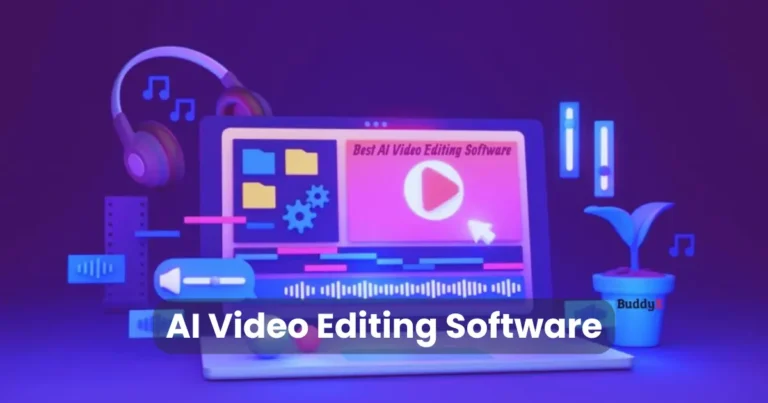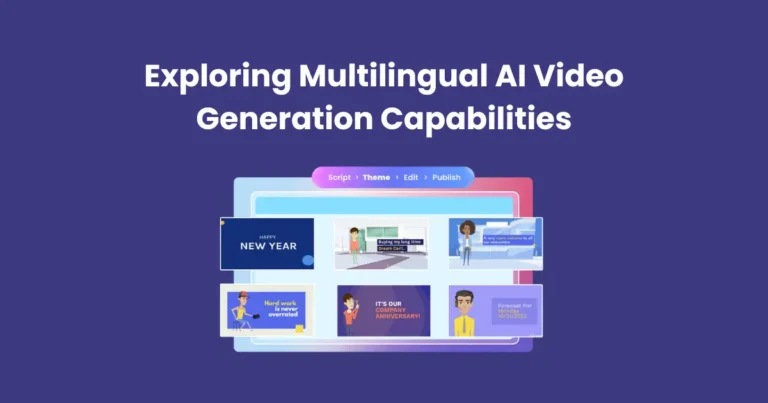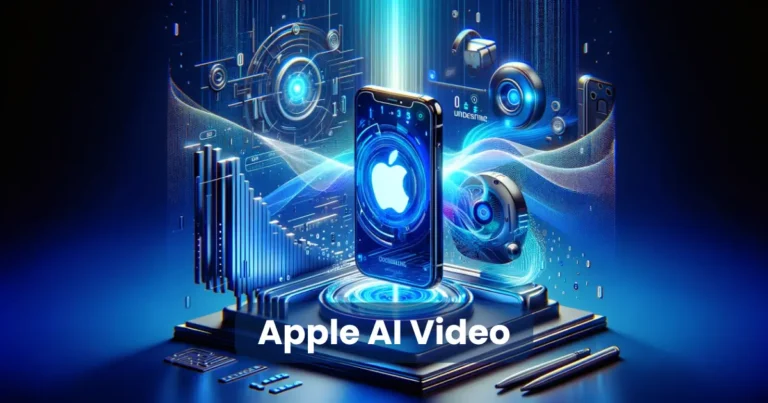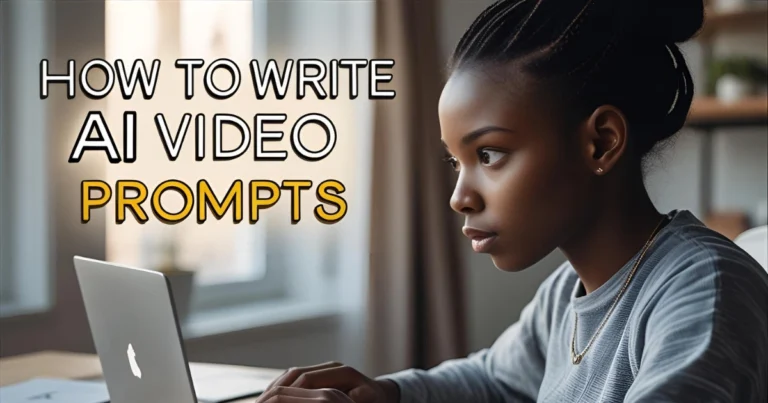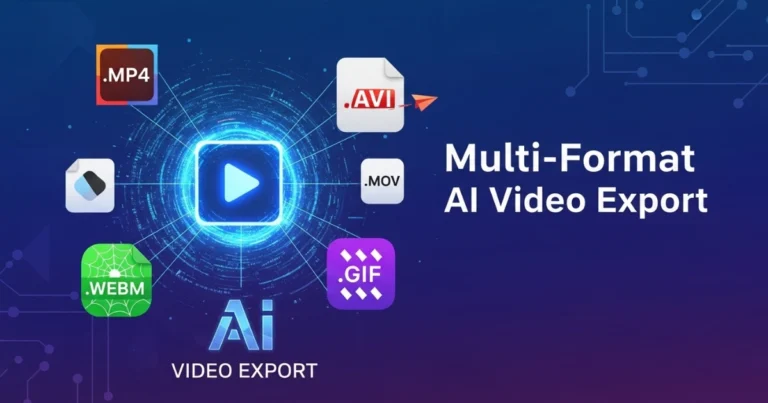Text to Animated Video AI
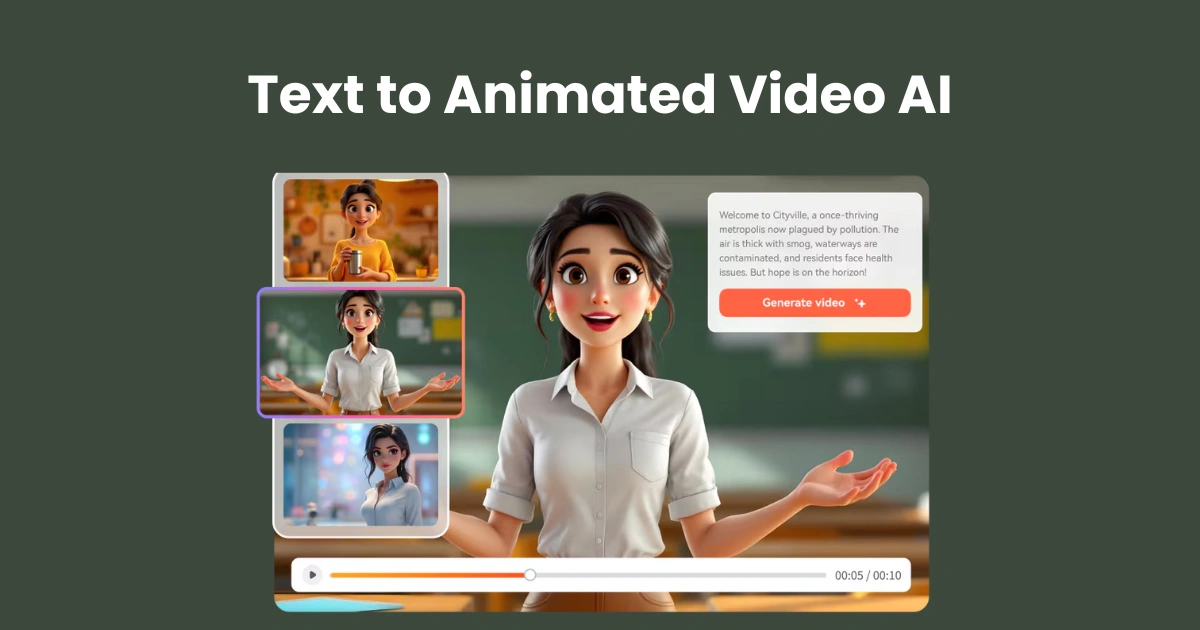
Contents
- 1 What Is Text to Animated Video AI?
- 2 How Text to Animated Video AI Works
- 3 Top Benefits of Using AI for Animated Videos
- 4 Best AI Tools for Text to Animated Video in 2025
- 5 Common Use Cases in Business, Education, and Marketing
- 6 Step-by-Step Guide: Creating an Animated Video from Text
- 7 Real Examples of AI-Generated Animated Videos
- 8 Future Trends in Text to Animated Video AI
In 2025, text to animated video AI is reshaping the way content creators, marketers, and educators bring ideas to life. Instead of spending hours animating scenes manually, creators now rely on AI tools that turn written text into dynamic, animated visuals within minutes. Whether you’re building an explainer video, a promotional clip, or an educational module, this innovative technology eliminates the barriers to video production.
Thanks to advances in artificial intelligence and natural language processing, generating animated videos from simple scripts has never been easier. As a result, professionals across industries are embracing this AI-powered approach to engage their audiences faster, more affordably, and at scale. In this article, we’ll explore how this game-changing tool works, which platforms are leading the way, and how you can start creating your own animated content today.
What Is Text to Animated Video AI?
Text to animated video AI is a cutting-edge technology that converts written content—such as scripts, articles, blog posts, or simple text prompts—into fully animated videos using artificial intelligence. These AI systems understand natural language, extract key ideas, and then pair them with relevant visuals, animations, characters, and voiceovers to create a complete video without requiring manual animation skills.
At its core, this technology combines several AI-powered capabilities:
- Natural Language Processing (NLP) to interpret and structure your text
- Generative visuals that match scenes and themes with the content
- AI voiceovers that read the script with human-like intonation
- Automated editing tools to compile transitions, effects, and background music
Instead of spending days creating visuals and editing footage, users can now produce engaging videos in a fraction of the time. Whether you’re promoting a product, educating an audience, or sharing a story, text to animated video AI provides a powerful, time-saving solution for modern video creation.
How Text to Animated Video AI Works
Text to animated video AI works by transforming written input into animated visuals through a series of intelligent, automated steps. The process begins the moment you paste or upload your text into an AI-powered video platform. From there, the tool analyzes your content, identifies keywords and context, and begins generating visual scenes that match your message.

Here’s a breakdown of how it typically works:
- Text Analysis
The AI uses Natural Language Processing (NLP) to understand your script’s tone, structure, and subject matter. It identifies important concepts, scene breaks, emotions, and characters. - Scene Generation
Based on the text, the AI selects relevant animated assets such as characters, backgrounds, objects, and movements. If the tool supports avatars or custom characters, it will animate them to reflect your script’s dialogue or narration. - Voiceover and Lip Sync
Most text to animated video AI platforms include AI voiceovers. You can choose a voice from the system’s library or upload your own. The AI then syncs the narration with the animated characters’ lip movements and expressions. - Visual Editing and Transitions
The platform automatically adds transitions, camera effects, and timing adjustments to ensure your video flows smoothly. Some tools even allow you to fine-tune colors, pacing, and soundtracks. - Export and Sharing
After reviewing the draft, you can export your video in various formats (MP4, HD, social media sizes) and publish it directly to your desired platforms.
This entire process can take as little as 10 to 30 minutes, depending on the tool and complexity of your text. With minimal manual input, text to animated video AI delivers high-quality videos that once required expert animation skills and hours of editing time.
Top Benefits of Using AI for Animated Videos
Leveraging text to animated video AI offers a range of powerful benefits, especially for creators who want to produce content quickly without sacrificing quality. From cost savings to accessibility, this technology is transforming the animation landscape in real time.

1. Faster Production Time
Traditional animation can take hours—or even days—to complete. With AI, you can turn a script into a finished video in under 30 minutes. The automation of scene creation, voiceovers, and editing significantly accelerates the process.
2. Cost-Effective
Hiring animators, voice actors, and editors can be expensive. AI eliminates the need for a large production team by combining all these tasks into one tool. Most platforms also offer budget-friendly subscription models.
3. No Technical Skills Required
Even if you’ve never animated before, you can still create professional-quality content. Text to animated video AI platforms offer drag-and-drop interfaces and prebuilt templates, making them incredibly user-friendly.
4. Scalability
Need to produce videos weekly—or even daily? AI allows you to scale your content production effortlessly. You can generate multiple videos for different audiences or platforms without starting from scratch every time.
5. Consistent Quality and Branding
AI tools often include customizable templates, brand kits, and consistent voiceover styles. This helps maintain brand identity across all your animated content without reinventing the wheel for each video.
6. Built-In Voiceovers
Forget hiring voice actors. Most text to animated video AI tools come with a library of natural-sounding AI voices in various accents and languages. Some even allow you to clone your own voice for a more personalized touch.
7. Global Reach
With multilingual support and auto-captioning features, you can easily localize your videos for global audiences, expanding your reach across different regions and languages.
Best AI Tools for Text to Animated Video in 2025
As text to animated video AI continues to evolve, several platforms are leading the charge in simplifying animation through artificial intelligence. Whether you need educational content, marketing videos, or social media animations, these tools offer robust features that turn plain text into visually compelling stories.
Here are the top AI tools to watch (and use) in 2025:

1. Pictory
Pictory transforms long-form content like blogs or whitepapers into short, engaging animated videos. You simply paste your script, choose a theme, and let the AI handle visuals, voiceovers, and editing. It’s perfect for repurposing written content into visual formats.
Key Features:
- Auto summarization
- Stock footage and animation library
- Text-to-speech and voiceover support
2. Synthesia
Synthesia stands out for its realistic AI avatars and multi-language voiceover capabilities. You input your script, select an avatar, and the tool animates a lifelike presenter to deliver your message.
Key Features:
- 140+ languages
- AI avatar customization
- Professional studio-quality output
3. Animaker
Ideal for beginners, Animaker uses text to animated video AI to create cartoon-style videos with drag-and-drop simplicity. It offers a wide library of animated characters, scenes, and transitions.
Key Features:
- Prebuilt templates
- Lip-syncing animations
- 1000+ animated assets
4. Lumen5
Lumen5 is perfect for marketers and social media creators. It converts blogs, news articles, or scripts into animated clips tailored for platforms like Instagram, YouTube, and LinkedIn.
Key Features:
- Automatic storyboard creation
- Brand customization tools
- AI voiceover and background music
5. InVideo AI
InVideo AI delivers instant video creation with a conversational interface. You enter your prompt or script, and it builds a complete video using AI-chosen templates, transitions, and effects.
Key Features:
- Real-time video generation
- AI-enhanced scene suggestions
- Templates for business, education, and social media
6. Veed.io
Veed.io integrates text to animated video AI with powerful editing features. It’s excellent for professionals who want quick automation plus customization options.
Key Features:
- Subtitles and translations
- Built-in screen recorder
- Team collaboration features
Why These Tools Matter
All these platforms aim to democratize video creation. By eliminating the need for complex software or hiring animators, they allow anyone to bring their ideas to life. Whether you’re a solo content creator or part of a large marketing team, these tools ensure that video creation is fast, affordable, and scalable.
Common Use Cases in Business, Education, and Marketing
Thanks to its speed and accessibility, text to animated video AI is becoming a go-to solution across industries. From boardrooms to classrooms and digital campaigns, this technology empowers users to create impactful videos that engage, inform, and convert.

Here are some of the most common and effective use cases:
Business: Simplifying Internal and External Communication
Companies are using text to animated video AI to streamline communication both inside and outside the organization.
- Training & Onboarding: HR teams turn policy documents and onboarding guides into animated walkthroughs.
- Product Demos: Sales teams use AI-generated videos to present product features to clients without needing expensive production.
- Internal Updates: Executives communicate strategies, performance updates, and announcements via short, engaging animated clips.
Why it works: AI videos grab attention, improve message retention, and reduce dependency on live presenters.
Education: Making Learning Visual and Engaging
In the education sector, educators and institutions are harnessing this technology to enhance learning.
- Lesson Delivery: Teachers transform lesson plans into engaging animations to improve student understanding.
- E-learning Modules: Online platforms use text to animated video AI to convert written content into dynamic tutorials.
- Language Learning: AI helps generate visual aids and native-sounding voiceovers for multilingual education.
Why it works: Animated videos break down complex topics into digestible visual formats, improving comprehension and student engagement.
Marketing: Boosting Reach and Engagement
Marketers love using text to animated video AI to create content that stands out in crowded digital spaces.
- Social Media Ads: Brands quickly generate eye-catching short videos from ad copy.
- Explainer Videos: Websites and landing pages showcase their products with animated explainers driven by AI.
- Email Campaigns: Marketers embed animated video summaries into newsletters to boost open and click rates.
Why it works: Animated content captures attention, increases dwell time, and drives more conversions than plain text.
Step-by-Step Guide: Creating an Animated Video from Text
Creating high-quality videos has never been easier, thanks to text to animated video AI. You don’t need animation experience or a professional studio setup. With the right AI tool, you can go from script to screen in just a few simple steps.

Here’s a step-by-step guide to help you get started:
Step 1: Choose the Right AI Platform
Start by selecting a trusted text to animated video AI tool. Popular choices include Pictory, Animaker, Synthesia, and InVideo AI. Each offers unique features, so pick one that aligns with your goals—whether it’s educational content, corporate videos, or social media clips.
Step 2: Prepare Your Script
Write a clear and concise script that communicates your message effectively. Break it into short, meaningful segments or scenes. Use simple language, especially if you’re targeting a wide or general audience.
Pro Tip: Include cues for tone, characters, or key visuals if the platform allows.
Step 3: Paste or Upload Your Text
Once your script is ready, paste it into the platform’s editor. Most text to animated video AI tools will automatically analyze your content and break it into scenes or slides.
Step 4: Select a Visual Style or Template
Choose a design style that matches your brand or message—animated characters, whiteboard visuals, corporate themes, etc. Templates help you maintain consistency and speed up production.
Step 5: Add Voiceover and Music
Pick an AI-generated voiceover that suits your tone—professional, friendly, enthusiastic, etc. Some tools also allow custom voice uploads. Then, choose a background music track from the built-in library.
Step 6: Customize Your Scenes
Now, fine-tune each scene. You can change backgrounds, characters, text placement, transitions, and animations. Most tools allow drag-and-drop editing, so the process is quick and intuitive.
Step 7: Preview and Polish
Use the preview feature to watch your full video. Make sure the flow is smooth, visuals match the text, and timing is spot-on. Adjust any scenes that feel off.
When you’re happy with the result, export the video in your preferred format—HD, 4K, or social media presets. Most text to animated video AI platforms offer direct sharing to YouTube, LinkedIn, and other channels.
Real Examples of AI-Generated Animated Videos
The impact of text to animated video AI isn’t theoretical—it’s already transforming how individuals and organizations communicate through visuals. Across industries, creators are leveraging this technology to produce stunning animated content that engages audiences and boosts results.

Here are several real-world examples showcasing its practical application:
Online Educators Enhancing E-Learning
Many online instructors now use platforms like Animaker or Pictory to convert text-based lessons into engaging video lectures. For instance, a digital marketing tutor transformed his blog on SEO strategies into a 5-minute animated video using text to animated video AI, making the content more digestible and shareable for students.
Result: Student retention increased by 35%, and course completion rates saw a notable boost.
Startups Creating Cost-Effective Explainer Videos
A SaaS startup used Synthesia to introduce a new app feature. By inputting a simple script and choosing a realistic AI avatar, the company created a polished explainer video in under 30 minutes—without hiring voice talent or animation experts.
Result: The video helped reduce customer support queries by 25% within the first week of release.
Social Media Creators Boosting Engagement
Content creators and influencers use text to animated video AI tools like Lumen5 to turn tweets, blog excerpts, and captions into fast, scroll-stopping animations. One lifestyle blogger converted a written guide on “5 Tips for Morning Routines” into a stylish 60-second video using AI.
Result: The video reached over 100,000 views on Instagram Reels and drove traffic back to her full blog post.
Healthcare Providers Simplifying Medical Concepts
A nonprofit healthcare organization employed InVideo AI to convert clinical information into short animated clips. By inputting a basic text script on “How to Manage Diabetes,” the AI generated a clear, friendly video for patients.
Result: The video was used in clinics and shared across social media, reaching 40% more people than previous educational materials.
Corporate Teams Improving Training
An HR department at a mid-sized company used Veed.io to transform training manuals into animated onboarding videos. New hires watched a welcome video created from the HR team’s script using text to animated video AI, making the process more engaging and consistent.
Result: Onboarding time was reduced by 50%, and employee satisfaction ratings improved.
Future Trends in Text to Animated Video AI
As artificial intelligence evolves, text to animated video AI is poised to become even more intelligent, personalized, and immersive. What once seemed like a futuristic tool is quickly becoming a creative standard. Looking ahead, several key trends are shaping the future of this technology—and redefining how we create video content.

1. Hyper-Realistic AI Avatars and Lip Sync
Future platforms will generate avatars with advanced facial expressions, body language, and realistic lip-syncing. These avatars will mimic human speech more accurately, making explainer videos, corporate training, and virtual storytelling more engaging and lifelike.
2. Multilingual and Real-Time Translation
With globalization on the rise, expect text to animated video AI tools to offer real-time translation and voice dubbing across dozens of languages. This will allow creators to reach global audiences without redoing entire scripts or hiring multilingual talent.
3. Smarter Contextual Scene Matching
AI engines are improving their ability to “understand” not just words, but context, tone, and emotional cues. Soon, these systems will automatically match scenes and animations with mood-appropriate visuals, creating a more cohesive and professional viewing experience.
4. Interactive and Personalized Videos
Another emerging trend is interactivity. AI will soon enable personalized animated videos tailored to the viewer’s preferences, name, behavior, or location. Think: onboarding videos that adapt based on job role or product explainers customized by user interest.
5. Seamless Integration with Creative Workflows
Expect to see text to animated video AI tools integrated directly into CMS platforms, project management software, and social media schedulers. This will streamline video production within existing workflows, saving even more time for marketers and educators.
6. Integration with AR/VR for Immersive Learning
As virtual and augmented reality grow, AI-generated animations will expand into immersive formats. Education and training sectors may soon use animated AR avatars powered by text inputs to guide learners in real-time.
Conclusion
In today’s fast-paced digital world, text to animated video AI is proving to be a game-changing solution for content creators, marketers, educators, and businesses alike. By turning written content into animated visuals within minutes, this technology empowers users to communicate ideas more effectively—without needing advanced technical skills or large production budgets.
From enhancing training modules to supercharging marketing campaigns, the versatility and efficiency of AI-driven animation make it an essential tool in any modern content strategy. As AI continues to evolve, the capabilities of these tools will only become more powerful, more intuitive, and more integrated into everyday workflows.
Now is the perfect time to embrace text to animated video AI and stay ahead of the curve. Whether you’re starting small or scaling fast, this technology puts professional video creation within everyone’s reach—quickly, affordably, and creatively.


